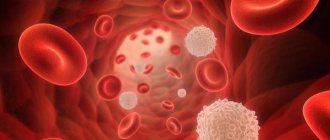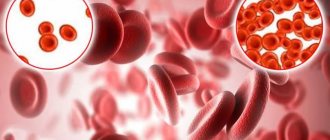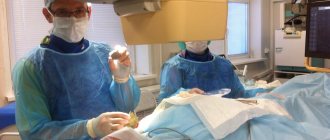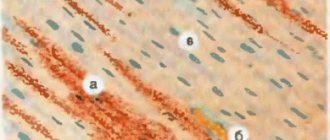The article was checked by general practitioner Mardanova O.A. , is for general informational purposes only and does not replace specialist advice. For recommendations on diagnosis and treatment, consultation with a doctor is necessary.
According to statistics from the World Health Organization, cardiovascular diseases are the most common cause of death on Earth. Thus, timely consultation with a doctor, correct diagnosis, effective treatment and constant prevention are especially important when it comes to the cardiovascular system.
It is generally accepted that the main sign of any disease of the cardiovascular system is chest pain. However, this is not entirely true: chest pain can also be felt by a healthy person, who has an easily excitable nervous system. At the same time, cardiac pathology can manifest itself in a completely different way, for example, an increase in blood pressure, in which the main complaint will be a general poor condition.
That is why, if there is any change in your health, we recommend contacting a therapist at the Yauza Clinical Hospital. Doctors at the therapy department will make a preliminary diagnosis and refer you to the necessary examinations and consultations with specialists.
What are cardiovascular diseases?
Cardiovascular diseases are a group of diseases of the heart and blood vessels that include:
- coronary heart disease - a disease of the blood vessels that supply blood to the heart muscle;
- cerebrovascular disease - a disease of the blood vessels that supply blood to the brain;
- Peripheral artery disease - disease of the blood vessels that supply blood to the arms and legs;
- rheumatic carditis - damage to the heart muscle and heart valves as a result of a rheumatic attack caused by streptococcal bacteria;
- congenital heart disease – deformations of the structure of the heart existing from birth;
- Deep vein thrombosis and pulmonary embolism - the formation of blood clots in the leg veins that can dislodge and move towards the heart and lungs.
Heart attacks and strokes are usually acute illnesses and occur primarily as a result of blockages in blood vessels that prevent blood from flowing to the heart or brain. The most common cause of this is the formation of fatty deposits on the inner walls of the blood vessels that supply blood to the heart or brain. Bleeding from a blood vessel in the brain or blood clots can also cause a stroke. Myocardial infarction and stroke are usually caused by a combination of risk factors such as tobacco use, unhealthy diet and obesity, physical inactivity and harmful use of alcohol, high blood pressure, diabetes and hyperlipidemia.
What diseases can electrocardiography (ECG) tell about?
An electrocardiogram (ECG) is considered the main diagnostic method for identifying various diseases of the cardiovascular system. Our heart works in the body under the control of its own pacemaker, which produces electrical impulses and directs them to the conduction system, and they are recorded on the ECG. It turns out that using an electrocardiogram, we can record a peculiar language of our myocardium. Based on the deviations of the main teeth: P, Q, R, S and T, it is possible to determine which disease is the basis of cardiovascular pathology.
Hypertrophy of the heart
Hypertrophy of the heart chambers occurs as a result of hemodynamic disturbances in the bloodstream, which provoke overload of the ventricles or atria. On the ECG you can see seven main signs of cardiac muscle hypertrophy:
- An increase in the time of internal deviation, since in the hypertrophied myocardium the excitation spreads longer in the area from the endocardium to the epicardium.
- An increase in the amplitude of the R wave, while the excitation vector is larger in magnitude.
- Ischemia of the subendocardial layers of the heart, due to the fact that they lack blood flowing through the coronary arteries.
- Conduction disturbance.
- Deviation of the electrical axis of the heart towards the hypertrophied section, as its mass increases due to the growth of cardiomyocytes.
- Changes in the electrical position of the heart.
- Displacement of the transition zone (V3), manifested by a change in the ratio of the R and S waves in the third chest lead.
Angina pectoris
The disease is characterized by attacks of anginal pain lasting from a few seconds to twenty minutes. This disease is one of the formischemic heart diseases. In the classic form of angina pectoris, electrocardiographic signs are manifested by changes in the final part of the ventricular QRS complex:
- Depression of the S-T segment.
- Various changes in the T wave, such as decreased amplitude, biphasicity, isoelectricity, or negativity.
- The focal nature of these changes: they are recorded in one or two leads, since the observed hypoxia is local in nature, developing in the basin of a separate branch of the coronary artery.
During the periods between attacks, the ECG often shows no pathological changes at all. In addition, the above-described deviations are possible in many other heart diseases and pathological conditions. That is why in some cases the diagnosis of angina pectoris can be difficult.
Arrhythmia
Pathology of the cardiovascular system associated with a violation of the formation of an excitation impulse or its spread throughout the myocardium. In most cases, it manifests itself as an interruption in the rhythm of heart contractions, with periods of acceleration and gradual deceleration. Typically, your heart rate increases as you inhale and decreases as you exhale. The features of the ECG are as follows:
- The frequency of changes in the R - R intervals is more than 0.1 seconds.
- Unlike other rhythm disturbances, there is a gradual change in the duration of the R – R interval, usually due to the T – P segment.
- Small fluctuations of P – Q and Q – T are characteristic.
The most reliable electrocardiographic sign of sinus arrhythmia is considered to be a gradual periodic shortening of the R - R section against the background of an increased rhythm and, conversely, a lengthening of the R - R intervals when the rhythm slows down.
Tachycardia
An increase in heart rate is called tachycardia. In this case, the heart rate accelerates to 100-150 beats per minute. A similar disorder can develop due to increased automatism of the sinus node. The pathology is also inherent in healthy individuals during physical exertion or emotional stress. The cause is often ischemia, dystrophic changes, various infections and toxic effects. Main ECG signs:
- There is a decrease in the R–R interval as the T–P interval shortens.
- With severe tachycardia, the P–Q segment shortens.
- The degree of increase in heart rate is directly proportional to the decrease in Q – T.
- An upward displacement of the RS – T segment downward from the isoelectric line.
- The amplitude and direction of the teeth correspond to the norm.
Bradycardia
A deviation that is manifested by a reduced heart rate (less than 60 per minute). It occurs with reduced automatism of the sinus node; it can occur even in healthy people, for example in athletes, when exposed to various factors. A common cause is considered to be an increase in the tone of the vagus nerve. The electrocardiographic picture, in principle, differs little from the norm, only the rhythm is slowed down. The following changes are noted on the ECG:
- The R interval increases due to the T – P shift.
- Q – T increases according to the decrease in rhythm frequency.
- The amplitude and vector of the teeth change slightly.
Heart aneurysm
A cardiac aneurysm is an enlargement of the myocardial cavity due to pathological changes in the muscle layers or abnormalities in the development of the organ at the stage of embryogenesis. The main signs of a cardiac aneurysm include protrusions in its area due to thinning of the wall, which can rupture. This is what can lead to irreparable consequences, which ECG research helps prevent. There are two leading signs that allow you to diagnose an aneurysm:
- The QS wave is present in leads where high R is usually recorded.
- A “frozen” ECG curve: instead of Q, a dome-shaped RS-T segment appears, shifted upward from the isoline, and sometimes a negative coronary T-wave appears.
Extrasystole
Extrasystole is the most common heart rhythm disorder. The pathology develops due to the appearance of an active heterotopic focus capable of generating an electrical impulse that interrupts the work of the sinus node. Manifested by extraordinary excitation and subsequent contraction of parts of the heart or its entirety:
- On an ECG, extrasystoles differ in shape, relation to the isoline, location of the P wave or width, direction of the QRST complex teeth.
- The presence of an increased pause (compensatory) after the extrasystole.
- Atrial extrasystole is characterized by: interval R(c)-R(e) <interval R(c)-R(c), there is a wave P(e), different from the wave P(c), an incomplete compensatory pause.
- The signs of ventricular extrasystole are as follows: interval R(s)—R(e) <interval R(s)—R(s), the P(e) wave is absent, the QRS complex is deformed, a complete compensatory pause.
Pulmonary embolism
Pulmonary embolism is accompanied by the development of pulmonary heart syndrome, since the resulting hypertension of the pulmonary circulation leads to acute overload of the right ventricle. In this case, the myocardium is in a state of hypoxia, and its hypertrophy develops. All of the above determines several ECG options for pulmonary embolism:
- SI-QIII-TIII syndrome: deep S waves in standard I and Q waves in leads III, while T waves in lead III become negative.
- acute hypertrophy of the right parts of the heart muscle, which is manifested by a high pointed P wave in standard lead II.
- acute supraventricular tachyarrhythmias.
In some cases, with acutely developing cor pulmonale, metabolic changes in the area of the right ventricle provoke the occurrence of complete or partial blockade of the right bundle branch.
Pericarditis
The dynamic picture of the ECG during pericarditis depends on its etiology. However, there are also common characteristics, for example: inflammation of the pericardial tissue changes its electrical status, which leads to the emergence of so-called “inflammatory currents” coming from the heart. It is these “currents” that are recorded by the electrode located above the myocardial area:
- This is graphically displayed on the ECG by the rise of the S-T segment in all leads (concordant rise of the S-T segment).
- There is no displacement of the RS segment – Tbelow the isoline level.
- Pathological Q-waves do not appear dynamically.
The above differences form and disappear in the case of acute pericarditis much more slowly than in the case of myocardial infarction. The appearance of effusion in the pericardial cavity is accompanied by a noticeable decrease in the voltage of all electrocardiographic waves, especially in the leads from the limbs of the subject.
Myocarditis
In all cases of myocarditis, parenchymal inflammation occurs and progresses in the wall of the ventricles, which is focal or diffuse in nature, affecting a certain area of the heart muscle:
- The total T vector tilts in the direction opposite to the affected area, and a low or negative T wave is displayed on the ECG.
- The S–T vector is directed towards the lesion.
- The RST segment is displaced up and down from the isoelectric line.
- Negative T can become symmetrical in acute myocarditis, it becomes pointed, as in coronary insufficiency. The localization of all noted disorders depends on the location of the inflammatory reaction.
These electrocardiographic shifts are best determined in the chest leads. A concomitant pathology is rhythm and conduction disturbances.
Myocardial dystrophy
Myocardial dystrophy is part of the complex of pathological clinical symptoms of menopausal hormonal changes in older people. The pathology is described by pain in the heart area, different from angina pectoris, and a disturbance in heart rhythm. There are cases when these symptoms occur before the onset of menopause. The most common electrocardiographic signs are the following:
- A negative but not deep “coronal” T wave or it may be biphasic with a negative second phase.
- Dynamic changes in electrocardiographic data.
- A slight shift of the RS – T segment downward from the position of the isoelectric line.
- More pronounced changes in the middle chest and right leads.
The main problem of ECG diagnostics is that many deviations and changes in the electrocardiographic picture are similar for a number of diseases. For example, coronary insufficiency, some forms of myocarditis and myocardial dystrophy are characterized by similar electrocardiograms. As practice shows, clinical symptoms need to coincide with the dynamics of ECG abnormalities. In this regard, it is important to note the development of the promising direction presented in the Kardi.ru project. The technique of monitoring the state of your heart allows you to register micro changes in the work of the heart muscle even before the appearance of serious disorders, which is displayed graphically by the CardiRu device and facilitates timely decision-making on appropriate therapeutic measures.
What are the risk factors for cardiovascular disease?
The main risk factors for heart disease and stroke are poor diet, physical inactivity, tobacco use and harmful use of alcohol.
The effects of behavioral risk factors on an individual may include increased blood pressure, increased blood glucose, increased blood lipids, and overweight and obesity. These “intermediate risk factors” can be assessed in primary care settings and may indicate an increased risk of myocardial infarction, stroke, heart failure and other complications.
Quitting tobacco use, reducing salt intake, consuming fruits and vegetables, regular physical activity and avoiding harmful use of alcohol have been shown to reduce the risk of developing cardiovascular disease. In addition, drug therapy may be necessary to reduce the risk of CVD and prevent heart attack and stroke in people with diabetes, high blood pressure, and elevated lipid levels. To increase people's motivation to make and maintain healthy behaviors, health policies are needed to create an enabling environment for healthy choices to be made and afforded to them.
In order for people to choose and maintain healthy behaviors, policies are needed to create an environment conducive to healthy choices, their accessibility and affordability.
There are also a number of factors that influence the development of chronic diseases, or underlying causes. They reflect the main driving forces leading to social, economic and cultural changes - globalization, urbanization and population aging. Other determinants of CVD include poverty, stress and genetic factors.
Major diseases of the cardiovascular system
The most common pathologies of the cardiovascular system include the following.
Hypertension is an increased level of blood pressure. The disease may be asymptomatic, or may be accompanied by such phenomena as dizziness, headache, tinnitus, flashing spots before the eyes, nausea, weakness, and insomnia.
Arrhythmia is a heart rhythm disorder. The main symptoms of arrhythmia include irregular, very rapid or slow heartbeat, dizziness, near fainting, and chest pain. In some cases, you may not feel any signs of abnormal heart rhythm.
Coronary heart disease (CHD) is a pathology in which myocardial damage occurs due to insufficient blood supply. Most often, symptoms of IHD appear during physical activity: chest pain, a feeling of lack of air, shortness of breath, swelling, interruptions in heart function, arrhythmia.
Heart failure is a complex of disorders caused primarily by a decrease in the contractility of the heart muscle. Symptoms of heart failure largely depend on which part of the heart is affected. These include cyanosis, shortness of breath, hemoptysis, rapid heartbeat, edema, and enlarged liver.
Acquired heart defects are diseases associated with disorders of the valvular apparatus of the heart and great vessels. The main manifestations are pain in the heart, shortness of breath, swelling, rapid heartbeat, cough, hemoptysis, chest pain during physical activity, dizziness, fainting.
What are the common symptoms of cardiovascular disease?
Symptoms of heart attack and stroke
Often the underlying blood vessel disease is asymptomatic. A heart attack or stroke may be the first warning sign of the disease. Symptoms of a heart attack include:
- pain or discomfort in the middle of the chest;
- pain or discomfort in the arms, left shoulder, elbows, jaw or back.
In addition, the person may experience difficulty breathing or shortness of breath; nausea or vomiting; feel dizzy or faint; break out in a cold sweat and become pale. Women are more likely to experience shortness of breath, nausea, vomiting, and back and jaw pain.
The most common symptom of a stroke is sudden weakness in the face, most often on one side, arm or leg. Other symptoms include sudden numbness of the face, especially on one side, arms or legs; confusion; difficulty speaking or difficulty understanding speech; difficulty seeing in one or both eyes; difficulty walking, dizziness, loss of balance or coordination; severe headache for no specific reason, as well as loss of consciousness or unconsciousness.
People experiencing these symptoms should seek medical help immediately.
What is rheumatic carditis?
Rheumatic heart disease is damage to the heart valves and heart muscle due to inflammation and scarring caused by rheumatic fever. Rheumatic fever is caused by an abnormal response of the body to a streptococcal infection. The disease usually first manifests itself as a sore throat or tonsillitis in children.
Rheumatic fever primarily affects children in developing countries, especially in settings where poverty is widespread. Worldwide, rheumatic carditis is associated with almost 2% of all deaths from cardiovascular diseases.
Symptoms of rheumatic carditis
- Symptoms of rheumatic heart disease include: shortness of breath, fatigue, irregular heartbeats, chest pain and loss of consciousness.
- Symptoms of rheumatic fever include: fever, joint pain and swelling, nausea, stomach cramps and vomiting.
The most common diseases of the cardiovascular system
Diseases of the cardiovascular system are widespread among the adult population of many countries around the world and occupy a leading place in overall mortality statistics. A person who does not have a medical education should at least understand in general terms what a particular heart or vascular disease is, so that if one suspects its development, he does not waste precious time, but immediately seeks medical help. That is why we bring to your attention this article, which reflects the signs of the most common diseases of the cardiovascular system.
Atherosclerosis
Atherosclerosis is a chronic, steadily progressing disease of arteries of predominantly large or medium caliber, which is the main cause of the development of various diseases of the heart and blood vessels.
This disease has now become an epidemic, causing about 50% of all deaths. Atherosclerosis begins at a young age and constantly progresses. In persons over 60 years of age, changes in the vascular wall, characteristic of one or another stage of atherosclerosis, are present in 100% of cases.
The cause of atherosclerosis is a violation of lipid metabolism in the body.
Risk factors for developing this disease are as follows:
- Non-modifiable (that is, those that the patient cannot influence): age (women over 55 years of age or younger during early menopause, men over 45 years of age); male gender; hereditary predisposition (early development of atherosclerosis in close relatives).
- Modifiable (those that the patient can, if desired, eliminate): smoking - regardless of the number of cigarettes smoked per day; high blood pressure – above 140/90 mm Hg. Art.; diabetes; body mass index more than 30 – obesity; especially - abdominal type of obesity - waist circumference in women is more than 88 cm, in men - more than 102 cm.
- Partially reversible: Changes in the biochemical blood test (the level of total cholesterol in the blood is more than 5.2 mmol/l, low-density lipoprotein (LDL in the analysis form) is more than 4.1 mmol/l or less than 0.9 mmol/l.
- Other factors: alcohol abuse; physical inactivity (low physical activity); taking oral contraceptives; unfavorable psychosocial environment – social isolation, depression, stress; drinking soft water.
Disorders of lipid metabolism, expressed in increased levels of cholesterol and triglycerides in the blood, trigger a number of pathophysiological mechanisms, which result in damage to the inner lining of the arteries and endothelium. This leads to platelets sticking to the damaged area, forming an atherosclerotic plaque. This plaque gradually increases in size, increasingly clogging the lumen of the vessel, and the organs that this vessel supplies with blood experience a lack of oxygen. The plaque can rupture, leading to thrombosis (blockage by a blood clot) - this mechanism underlies unstable angina, myocardial infarction and sudden death.
Coronary heart disease (CHD)
IHD is an extremely important medical problem because it is characterized by extremely high prevalence and mortality.
More than half of deaths from cardiovascular diseases are due to ischemic heart disease. Every fifth man aged 50-59 years suffers from this pathology, and morbidity and mortality rates are becoming higher every year.
Coronary heart disease is a disease caused by atherosclerotic damage to the heart vessels - the coronary arteries, leading to an imbalance between the supply and demand of the heart muscle for oxygen - the development of myocardial ischemia.
Factors that increase the risk of developing coronary heart disease are:
- Main factors: imbalance of lipids in the blood; high blood pressure; smoking; diabetes; complicated heredity (sudden death or myocardial infarction in close relatives under the age of 55 years for men and 65 years for women).
- Minor factors: excess body weight; hormone replacement therapy after early menopause; taking oral contraceptives; psychosocial factors; infectious factors (cytomegalovirus, chlamydia, Helicobacter pylori); alcohol abuse; left ventricular hypertrophy; changes in the biochemical blood test (increased levels of triglycerides, lipoprotein, fibrinogen, homocysteine, procoagulants, the presence of inflammatory markers).
There are 6 forms of coronary heart disease, differing in the mechanism of development and features of the clinical course:
- Sudden coronary death. This form is defined as death that occurs in the presence of witnesses, instantly or within 60 minutes from the onset of acute symptoms, preceded by a sudden loss of consciousness, in a healthy person or a sick person, but in satisfactory condition. The main risk factor for this form of coronary artery disease is dysfunction of the left ventricle of the heart.
- Angina pectoris. A form of ischemic heart disease characterized by attacks of chest pain in response to myocardial ischemia, which occurs due to exposure to factors that provoke it. The main provoking factor is physical activity (both industrial work and everyday stress - lifting weights, walking down the street, climbing stairs). An angina attack can also be triggered by psycho-emotional stress, caused not only by negative, but also by positive emotions. Less commonly, the causes of an attack include sexual intercourse, excess food intake, exposure to cold (both general and local), overexertion during bowel movements - if the patient is constipated. If medical attention is not provided, angina will progress and lead to unstable angina.
- Unstable angina. This form of coronary artery disease includes new-onset, progressive and post-infarction angina. This is a period of exacerbation of coronary heart disease, characterized by an increase in the severity of painful attacks and is a leading risk factor for the development of large-focal myocardial infarction.
- Acute myocardial infarction (MI). One of the most dangerous cardiovascular diseases and diseases of internal organs in general. It is characterized by extremely high mortality - the frequency of acute MI among men over 40 years of age ranges from 2-6 cases per 1000 people. Every year about 500,000 people die from this pathology. Myocardial infarction is a condition that occurs as a result of a sudden cessation of coronary blood flow due to thrombosis of a coronary vessel and the development of foci of necrosis (death) in the heart muscle. If emergency care is not provided in a timely manner, and in some cases even when it is provided, the disease ends in the death of the patient.
- Cardiosclerosis. Morphologically, it represents small areas of replacement of cardiac muscle tissue with connective tissue. Essentially these are scars. Cardiosclerosis develops after acute diseases of the heart muscle (for example, after a heart attack) or against the background of chronic heart pathology (for example, with myocardial dystrophy). Areas replaced by scar tissue are unable to perform their function and can cause arrhythmias, heart valve defects, and chronic heart failure.
- Painless form of ischemic heart disease. Temporary disruption of the blood supply to the myocardium in the absence of signs of angina. At moments of ischemia, in some cases it is possible to register changes on the ECG characteristic of ischemic heart disease. The risk of acute myocardial infarction or sudden death in people suffering from silent myocardial ischemia is very high, since they are unaware of their disease, and therefore do not attempt to treat it.
Arterial hypertension
Persistently high blood pressure is one of the most common cardiovascular diseases; it has acquired the proportions of a non-infectious epidemic.
Every third adult in the world has high blood pressure, that is, suffers from one of the forms of arterial hypertension.
According to the WHO (World Health Organization), arterial hypertension is constantly elevated blood pressure: systolic - above 140 mm Hg. Art., diastolic – above 90 mm Hg. Art. The blood pressure level at diagnosis should be determined as the average of two or more measurements during at least two examinations by a specialist on different days. Essential hypertension, or essential hypertension, is high blood pressure in the absence of an obvious reason for its increase. Accounts for about 95% of all cases of arterial hypertension.
The main risk factors for this disease are the same factors that contribute to the development of ischemic heart disease and atherosclerosis, and the course of hypertension is aggravated by the following accompanying pathology: diabetes mellitus; cerebrovascular diseases - ischemic or hemorrhagic strokes, transient ischemic attack (TIA); heart diseases – myocardial infarction, angina pectoris, heart failure; kidney diseases - diabetic nephropathy, chronic renal failure; peripheral arterial disease; retinal pathology – papilledema, hemorrhages, exudates.
If a patient suffering from hypertension does not receive therapy that helps lower blood pressure, the disease progresses, hypertensive crises occur more and more often, which sooner or later can cause all sorts of complications: acute hypertensive encephalopathy; pulmonary edema; myocardial infarction or unstable angina; stroke or transient ischemic attack; arrhythmias; aortic dissection; acute renal failure; eclampsia - in pregnant women.
Secondary, or symptomatic, hypertension is a persistent increase in blood pressure, the cause of which can be determined. It accounts for only 5% of cases of arterial hypertension.
Of the diseases that lead to increased blood pressure, the most frequently diagnosed are: damage to kidney tissue; adrenal tumors; diseases of the renal arteries and aorta (coarctation); pathology of the central nervous system (brain tumors, encephalitis, polyneuritis); blood diseases (polycythemia); pathology of the thyroid gland (hypo-, hyper-, hyperparathyroidism) and other diseases. Complications of this type of arterial hypertension are the same as with hypertension, plus complications of the underlying disease that provoked hypertension.
Heart failure
A frequently occurring pathological condition, which is not an independent disease, but is a consequence, outcome of other acute and chronic heart diseases.
In this condition, due to changes in the heart, its pumping function is disrupted - the heart is unable to supply all organs and tissues with blood. Complications of heart failure are: arrhythmias; congestive pneumonia; thromboembolism; liver cirrhosis and liver failure; chronic renal failure (the so-called “stagnant kidney”); cardiac cachexia (exhaustion); cerebrovascular accidents.
Acquired heart defects
Acquired heart defects occur in approximately 1-10 people per 1000 population, depending on the region of residence, and account for about 20% of all heart lesions of an organic nature.
The main reason for the development of acquired heart defects is rheumatic damage to the valves: 70-80% of all defects are pathology of the mitral valve, the second place in the frequency of damage belongs to the aortic valve, stenosis and/or insufficiency of the tricuspid valve and pulmonary valve are relatively rarely diagnosed. This pathology affects people of different age groups. Every 2nd patient with heart disease requires surgical treatment.
The essence of the disease is that, under the influence of etiological factors, the heart valves lose the ability to function normally: stenosis is a narrowing of the valve, as a result of which it does not allow enough blood to pass through, and the organs experience a lack of oxygen, or hypoxia; insufficiency - the valve leaflets do not close completely, as a result of which blood is thrown from the part of the heart located below to the part located above; the result is the same - the organs and tissues of the body do not receive the vital oxygen they need, and their function is impaired.
Complications of heart defects include many conditions, among which the most common are acute pulmonary edema, infectious bronchopulmonary complications, chronic circulatory failure, atrial fibrillation, thromboembolism and others.
Myocarditis
Myocarditis is an inflammatory disease of the heart muscle caused by infection, infestation of parasites or protozoa, physical or chemical factors, or occurring in autoimmune, allergic diseases, as well as after heart transplantation.
The prevalence of myocarditis is 4-11% of diseases of the cardiovascular system. Myocarditis is especially often diagnosed during a control ECG after a viral infection.
Clinically, myocarditis is manifested by attacks of chest pain, signs of valve pathology, symptoms of arrhythmias, and circulatory disorders. May be asymptomatic. The prognosis for this disease depends on the severity of its course: mild and moderate forms, as a rule, result in complete recovery of the patient within 12 months after the onset of the disease, while severe forms can lead to sudden death, refractory circulatory failure and thromboembolic complications.
Cardiomyopathies
Cardiomyopathies are independent, steadily progressing forms of damage to the heart muscle of unclear or controversial etiology.
Within 2 years, about 15% of patients die from some forms of this disease in the absence of symptoms, and up to 50% in the presence of symptoms corresponding to the disease. They are the cause of death in 2-4% of adults, and are also the leading cause of sudden death in young athletes.
The probable causes of cardiomyopathies are: heredity; infection; metabolic diseases, in particular glycogenosis; lack of certain substances in the diet, in particular selenium, thiamine; pathology of the endocrine system (diabetes mellitus, thyrotoxicosis, acromegaly); neuromuscular pathology (muscular dystrophy); exposure to toxic substances - alcohol, drugs (cocaine), certain medications (cyclophosphamide, doxorubicin); diseases of the blood system (some types of anemia, thrombocytopenia).
Clinically, cardiomyopathies are manifested by all sorts of symptoms of cardiac dysfunction: angina attacks, fainting, palpitations, shortness of breath, cardiac arrhythmias. Cardiomyopathy is especially dangerous due to the increased risk of sudden death.
Pericarditis
Pericarditis is an inflammation of the layers of the lining of the heart - the pericardium - of infectious or non-infectious etiology. Areas of the pericardium are replaced by fibrous tissue, and exudate accumulates in its cavity. Pericarditis is divided into dry and exudative, acute and chronic.
Factors that cause pericarditis are: viral or bacterial infection; mushrooms; parasites; metabolic disorders (renal failure, uremia); heart diseases – myocardial infarction, myocarditis; trauma – with damage directly to the pericardium; autoimmune diseases - acute rheumatic fever, rheumatoid arthritis and others.
Clinically manifested by chest pain, shortness of breath, fever, muscle pain, combined with signs of the underlying disease. The most serious complication of pericarditis is cardiac tamponade - the accumulation of fluid (inflammatory or blood) between the layers of the pericardium, preventing normal contractions of the heart.
Infective endocarditis
It is an inflammatory lesion of valve structures with subsequent spread to other organs and systems, resulting from the introduction of a bacterial infection into the structures of the heart.
This disease is the 4th leading cause of death in patients from infectious pathology. In recent years, the incidence of infective endocarditis has increased significantly, which is associated with the wider spread of surgical interventions on the heart. It can occur at any age, but it most often affects people between 20 and 50 years of age. The ratio of incidence between men and women is approximately 2:1.
Infective endocarditis is a potentially life-threatening disease, so timely diagnosis, adequate, effective treatment and rapid identification of complications are extremely important to improve the prognosis.
Arrhythmias
Heart rhythm disturbances are not separate diseases, but are manifestations or complications of any pathological conditions associated with heart disease or non-cardiac pathology.
They can be asymptomatic for a long time, and can pose a danger to the patient’s life.
There are many types of arrhythmias, but 80% of them are due to extrasystole and atrial fibrillation.
Clinically, arrhythmias are manifested by a feeling of interruptions in the functioning of the heart, dizziness, shortness of breath, weakness, a feeling of fear and other unpleasant symptoms. Their severe forms can provoke the development of cardiac asthma, pulmonary edema, arrhythmogenic cardiomyopathy or arrhythmic shock, and also cause sudden death of the patient.
Which doctor should I contact if I feel unwell? If you have pathology of the cardiovascular system, you need to consult a cardiologist.
How can the burden of cardiovascular disease be reduced?
For the prevention and control of cardiovascular disease, WHO has identified a number of “best buys,” or highly cost-effective interventions that are feasible even in low-resource settings. They include 2 types of interventions—population-based and individual-level interventions—that can be used in combination to reduce the high burden of cardiovascular disease.
Examples of interventions that can be implemented to reduce CVD at a national level include the following:
- comprehensive tobacco control policies;
- taxation to reduce consumption of foods high in fat, sugar and salt;
- building walking and cycling paths to increase physical activity levels;
- strategies to reduce the harmful use of alcohol;
- ensuring proper nutrition for children in schools.
To prevent first myocardial infarctions and strokes, individual health interventions should target individuals with moderate or high overall cardiovascular risk or those with individual risk factors such as diabetes, hypertension and hypercholesterolemia above recommended levels. carrying out treatment.
The former (an integrated approach that takes into account all risk factors) is more cost-effective than the latter and can significantly reduce the incidence of cardiovascular events. This approach is feasible in low-resource settings, including the use of non-physician medical personnel.
For secondary prevention of CVD in people with pre-existing disease, including diabetes, treatment with the following medications is necessary:
- aspirin;
- beta blockers;
- angiotensin-converting enzyme inhibitors;
- statins.
The positive results obtained are largely unrelated, but when used in combination with smoking cessation, almost 75% of recurrent vascular events can be prevented. There are currently significant gaps in the implementation of these measures, especially at the primary health care level.
In addition, treatment of CVD sometimes requires expensive surgery. These include:
- coronary artery bypass grafting;
- balloon angioplasty (in which a small balloon catheter is inserted through an artery to restore lumen to a blocked vessel);
- plastic and valve replacement;
- heart transplant;
- operations using an artificial heart.
Some CVDs require medical devices to treat. These devices include pacemakers, artificial valves, and patches to close holes in the heart.
Treatment of cardiac diseases
Cardiovascular diseases are one of the most popular groups of ailments, affecting almost half of the population! Treatment of cardiac diseases is expensive in advanced cases. Such diseases can lead to disability and sometimes death.
In this regard, a lot of time, effort and money are devoted to the problems of cardiovascular diseases. New treatment methods and medications are being developed, but despite this, the volume of diseases remains at the same level. How to treat and what are the symptoms? Let's look at this in more detail.
Prerequisites for diseases
There are three main enemies of health. Much has been said and written about them, but it is worth emphasizing them once again:
- Poor nutrition. In most cases, obesity appears over time due to excessive consumption of fatty foods, snacking on sandwiches, lack of breakfasts, large dinners and fast food. If you eat enough vegetables and fruits, cereals, soups, or better yet, create a menu for your ideal diet with a nutritionist, this will significantly affect your well-being.
- Drinking alcohol and cigarettes. Advertisements and doctors constantly talk about the dangers of smoking and alcohol, but despite these facts, this is one of the main problems of many diseases, not only cardiological ones.
- Lack of sports in life. Physical activity has a beneficial effect on the entire body. You shouldn’t spend all your free time in the gym; it’s enough to do exercises every morning and, for example, jog three times a week. This will have a positive effect on your health.
Symptoms of diseases
- Shortness of breath during physical exertion, climbing stairs. In extreme cases, shortness of breath occurs in a horizontal position.
- Swelling of the extremities – regardless of the time of day, the arms and legs swell.
- Pain in the heart and sternum during physical activity.
- Unstable pulse. It can jump from 50 beats per minute to 100 and back.
- Unstable blood pressure.
- Interruptions in the heart.
If you find any of the points described, then you should urgently make an appointment with a cardiologist. Even if you do not have any of the above, you need to undergo examination as a preventative measure.
Cardiac Treatment Options
The methods depend on the disease itself, the stage of its progression, neglect, and age of the patient. Currently, the following methods exist:
- The medication option is one of the most common. There are whole complexes of drugs that will help you cure one or another cardiovascular disease.
- Surgery is required in extreme cases.
- Herbs are especially useful for prevention. They can also cure some diseases, but if surgery is necessary, they are unlikely to help.
- Homeopathy.
- Sanatorium-resort. This option has been used since the 19th century. And it still remains quite popular. Under the influence of factors (sports, nutrition, procedures, good air), the disease can be completely eliminated or its development can be slowed down.
Treatment of cardiac diseases can result in a series of expenses and endless treatments. It is important to listen to your body and in case of any unpleasant symptoms, consult a doctor. It is better to play it safe and be proven wrong than to spend many years on treatment.
Minimize your risk of heart disease by maintaining a healthy lifestyle.
Author
Demidova Alla Sergeevna
therapist, cardiologist, gastroenterologist
Doctor of the highest category
Experience 34 years
+7
WHO activities
Under WHO's leadership, in 2013, all Member States (194 countries) agreed on global frameworks to reduce the burden of preventable NCDs, including the Global Action Plan for the Prevention and Control of NCDs 2013–2020. The plan aims to reduce premature deaths from NCDs by 25% by 2025 through 9 voluntary global targets. 2 of these global goals directly address the prevention and control of CVDs.
Goal six of the Global NCD Action Plan aims to reduce the global prevalence of high blood pressure by 25%. High blood pressure is one of the main risk factors for cardiovascular disease. The global prevalence of high blood pressure (defined as systolic and/or diastolic pressure ≥140/90 mmHg) among people aged 18 years and over in 2014 was about 22%.
To achieve this goal, it is necessary to reduce the incidence of hypertension through national policies that address behavioral risk factors, including harmful use of alcohol, physical inactivity, overweight, obesity and high salt intake. Early detection and cost-effective management of hypertension to prevent myocardial infarction, stroke, and other complications requires a risk-based approach.
Goal eight of the Global NCD Action Plan aims to ensure that at least 50% of eligible people receive drug therapy and counseling (including glycemic control) to prevent myocardial infarction and stroke. Preventing heart attack and stroke using a comprehensive approach that takes into account overall cardiovascular risk is more cost-effective than treating based solely on individual risk factor thresholds and should be part of the core package of services to achieve universal health coverage. sanitary assistance. Achieving this goal will require strengthening key components of the health system, including financing health care services to ensure access to essential health technologies and essential medicines for NCDs.
In 2015, countries will begin setting national targets and measuring progress against the 2010 baselines set out in the Global Noncommunicable Disease Status Report 2014. The UN General Assembly will hold its third high-level meeting on NCDs in 2021 to review countries' progress towards achieving the voluntary global targets by 2025.









